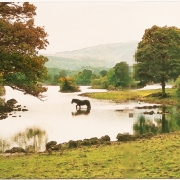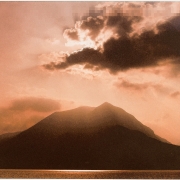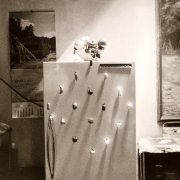Re:Collection / Memoriam: Cjala Surratt on John Pfahl
“Strangers with puzzled looks were amazingly cooperative in letting me into their rooms with my photographic gear. They let me take down the curtains, wash the windows, and rearrange the furniture. Often, too, they expressed their desire to share their view with others, as if it were a nondepletable treasure. I liked the idea that my photographic vantage points were not solely determined by myself. They were predetermined by others, sometimes years earlier, and patiently waited for me to discover them.” — John Pfahl on his series, Picture Windows
With great sadness, we share news of photographer John Pfahl’s recent passing, due to pre-existing medical conditions complicated by COVID-19. Pfahl was an alum of Fine Arts (’64) and S.I. Newhouse School of Communications (’68) at Syracuse University. A supporter of Light Work, Pfahl was a beloved University of Buffalo professor and earlier taught at the Rochester Institute of Technology. A wonderfully inventive artist, he pioneered new digital photographic procedures in both printing and digitizing negatives in an image-making career that spanned more than thirty years. Pfhal practiced a photographic sleight-of-hand that skewed the landscape by manipulating the optics of the camera with objects or digitized interruptions. Light Work’s permanent Collection holds a number of images from Pfahl’s seminal portfolio, Permutations on the Picturesque, that particularly exemplify his unique approach.
Pfahl’s Horse at Rydal Water, Lake District, England (1995/1997) presents an idyllic meadow containing the pastoralist’s usual muses—horse, pasture, watering hole, lush green foliage—a site of nature in respite, save an interruption by the artist’s hand. Two pixelated bars on the left side of the image create a stammer in the viewers’ gaze. Here, Pfahl extends the opportunity to stop and consider the interjection, its purpose, and his own intent as the image-maker.
Many prominent collections hold his work, including Albright-Knox Art Gallery, Center for Creative Photography, George Eastman House, J. Paul Getty Museum, Los Angeles County Museum of Art, Metropolitan Museum of Art, Museum of Fine Arts, Houston, The Museum of Modern Art, Princeton University Art Museum, and San Francisco Museum of Modern Art. Pfahls’s photobooks include Altered Landscapes: The Photographs of John Pfahl (Friends of Photography, 1982), Picture Windows (New York Graphic Society, 1987), A Distanced Land (with Estelle Jussim, UNM/Albright-Knox Gallery, 1990), Permutations on the Picturesque (Light Work, 1997), Waterfall (with Deborah Tall, Nazraeli Press, 2000), and Extreme Horticulture (with Rebecca Solnit, Verlag, 2003).
John’s works and tireless contributions as an educator, innovator, photographer, and author are witnesses to his passions as an artist. Light Work considers it an honor that our permanent Collection holds fifteen pieces of John Pfahl’s photographic legacy for posterity. John’s wife, Bonnie Gordon, and his brother, Walter Pfahl, survive him. We are among the many who keenly miss him.
—
View John Pfhal’s images in Light Work’s Collection here.
Browse John Pfhal’s recent work on his website.



